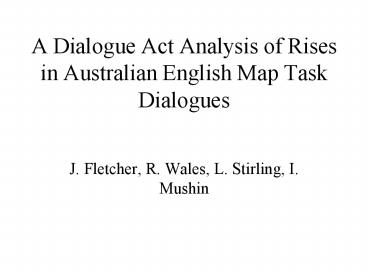A Dialogue Act Analysis of Rises in Australian English Map Task Dialogues - PowerPoint PPT Presentation
1 / 13
Title:
A Dialogue Act Analysis of Rises in Australian English Map Task Dialogues
Description:
... include attitudinal and semantic nuances like encouraging, doubtfulness, etc. ... onset rises are relatively clear, but the nuances of the fall-rises could not be ... – PowerPoint PPT presentation
Number of Views:27
Avg rating:3.0/5.0
Title: A Dialogue Act Analysis of Rises in Australian English Map Task Dialogues
1
A Dialogue Act Analysis of Rises in Australian
English Map Task Dialogues
- J. Fletcher, R. Wales, L. Stirling, I. Mushin
2
The major intonational tunes of AuE and BE/ AE
are considered to be more or less identical.
Differences in dialect are due to differences in
tune use. Ex Statements in AuE are sometimes
realized with a simple terminal high rise.
Claim a high rise in AuE is used for both
statements and yes/no questions (whereas in BE it
is only used for yes/no questions)
3
two kinds of rises (simple rises)1. statement
risestarts relatively low and rises to a high
level2.question risestarts relatively high
and continues to rise
- not phonologically identical
4
statement high rise
yes/no question rise
5
Another source of dialectal difference can be
found in fall-rising tunes (complex rises)
- low range fall-rise
- starts high, falls, rises again
2. high range fall-rise starts
high, falls, rises well beyond the pitch level at
the beginning
6
low range fall rise
high range fall rise
7
What functions do these fall-rises have in AuE?
In BE functions of fall-rises include attitudinal
and semantic nuances like encouraging,
doubtfulness, etc.
Eight dialogues from the ANDOSL Map Task were
selected, - annotated according to ToBi
conventions - coded for turns (turn a stretch
of talk), to see whether rises ocurred
turn-finally or turn-medially.
8
The simple and complex rises were transcribed as
follows
high onset high rise HH-H or
LH H-H
low onset high rise L H-H
low rise LL-H
low range fall rise HL- H
high range fall rise H L H-H
rise-fall-rise LHL-H
9
Dialogue acts were coded for forward
communicative functions and backward
communicative functions
forward communicative functions statements,
information requests, action directives
backward communicative functions agreement,
understanding, answer
10
- simple high rises
- high onset high rises (H H-H) were associated
with information requests (forward looking
functions)
- low onset high rises (L H-H) were associated
with action and statement directives, and
backward communicative functions
complex rises
- high range fall-rises (HL H-H) were
associated with forward communicative functions
- low range fall-rises (H L-H) were used for
both forward and backward comm. functions, but
never concluded information requests
11
The most frequent simple rise, the low onset high
rise (L H-H) was associated with statements,
instructions, action directives. The rises in
final position were associated with
acknowledgements, answers.
Dialogue acts corresponding to information
requests were realized as high onset high rises
(H H-H) The majority of these rises were
turn-final.
high range fall-rises were associated with same
kind of forward communicative functions as low
onset rises low range fall-rises often
concluded the same kind of dialogue acts as low
rises (answers, agreements, etc.)
12
In interactive dialogue (like the map Task) the
cooperative function of rising intonation (esp.
simple high rises with backward looking functions
,like answers and agreements) was emphasized.
The statement high rise has a continuative
function. The task follower often used these
rises to signal that they were expecting further
instruction from the task leader.
13
The semantic differences of high and low onset
rises are relatively clear, but the nuances of
the fall-rises could not be clearly distinguished.
The high range fall- rises might sometimes imply
speaker uncertainty, or polite softening.































